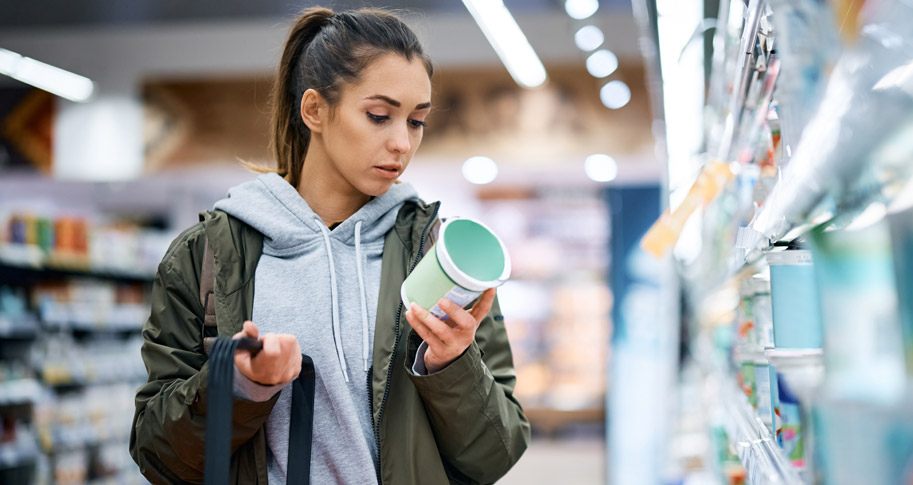
Consumers want to make healthy decisions when buying food and are often willing to pay a premium for it. Most shoppers, however, don’t have the detailed, specific knowledge to understand ingredient lists on the back of packages. Instead, they rely on easy rules of thumb (low fat content, no difficult to read ingredients, no GMOs, etc.) that may not always indicate the overall healthfulness of a product.
Processed food manufacturers can make this more difficult for consumers by using words on the front of a package like “natural,” “healthy,” and “organic,” which often short-circuit a more detailed evaluation of the product’s healthfulness or the rules of thumbs consumers normally use. And while “organic” is regulated by the USDA, many of these claims, such as natural, are not, so it’s unclear what they communicate about a product’s healthfulness.
In an effort to better understand how to disclose information to support consumers’ product evaluations and preferences, distinguished professor of marketing Scot Burton investigated how these different terms on the front of the package and graphics indicating the product’s processing interacted with consumers’ impressions of a product. Burton conducted his research with Garrett Rybak (US Air Force Academy) and Christopher Berry (Colorado State University), both Walton College alums. The trio’s research, “Reducing the Negative Impact of Ultra-Processed Foods: Consumer Response to Natural Claims, Organic Claims, and Processing Level Disclosures,” was recently published in the Journal of Business Research.
Their research shows that a stop-sign shaped graphic that explains a food is ultra-processed helps to offset the positive assumptions consumers make from marketing terms like “natural” and “organic.” The goal is not to take away consumers’ choices, but rather to disclose information that nudges them in the right direction and supports desires for healthier lifestyles through their food choices.
Burton, Rybak, and Berry’s research is important and timely because the FDA is currently investigating whether it should add regulation around terms like "healthy" and “natural” and how it should communicate product healthfulness on food packaging. Previous medical research has shown that high levels of ultra-processed food consumption is linked to greater risks of cardiovascular disease, diabetes, some cancers, and obesity. Military and defense personnel have even described the U.S.’s climbing rate of obesity and other metabolic disorders as a national security risk!
NOVA Classes
The researchers point out that we one way to indicate the processing level of a food is based on the NOVA classification system. Although you may frequently see it written out like an acronym, “nova” just means “new” in Portuguese because it was developed in Brazil during the ‘00s. It is a new classification for a new food environment. The system rates food not based on its micro- or even macronutrient profile but on the level of its processing. It is already used in places like Brazil and France to help their consumers make more informed food choices.
In this system, food is assessed on a scale of 1 to 4. NOVA Class 1 foods are either whole foods or minimally processed foods such as vegetables, fruits, meats, eggs, and most dairy. Class 2 foods have some degree of processing and are usually used by home cooks as ingredients. These are things like butter, sugar, flour, and spices.
NOVA Class 3 foods are processed foods, but they’re the kind of processed foods you could produce yourself. Think foods like bread (of the only flour, water, salt, and yeast variety) or a pot roast or a simple tomato sauce, even with a dash of sugar to bring down the acidity. These are by their nature some combination of NOVA Classes 1 and 2 and generally made with few ingredients that you can reasonably expect to find in a home kitchen.
Ultra-processed foods make up the final NOVA class. Generally speaking, these foods can really only be produced in a factory or commercial kitchen, and they’re engineered to be highly palatable with very long shelf lives. They’re created with preservatives, additives, and hydrogenated oils to keep them from spoiling. They’re often high in salt, saturated fat, and/or sugar. Their ingredient lists often are full of syrups and pastes and gums and emulsifiers from foods that have been splintered into their constituent parts.
Foods like Twinkies, Pringles, hot dogs, carbonated soft drinks, cookies and candy bars might come immediately to mind. But you might be surprised to learn much of our packaged sandwich bread, boxed breakfast cereals, canned soups, and frozen meals are also included in NOVA Class 4 foods.
The problem here isn’t NOVA Class 4 foods in and of themselves. Rather, it is the quantity of such foods we are eating. All across the world, these foods take up a larger and larger share of our grocery carts, and in many Western countries, people are eating more of these than any other kind of food. This increased quantity is especially alarming because a high intake of NOVA Class 4 foods is associated with obesity, cardiovascular events, and diabetes.
Stop Signs
Burton, Rybak, and Berry chose to use the stop sign graphic following the success of Chile’s nutrient-based stop sign packaging graphic. Almost a decade ago, Chile required food manufacturers to place a simple, black stop sign on the front of food packaging to indicate if a product was high in sugar, saturated fat, sodium, and/or calories. The campaign was incredibly successful and helped Chileans consume 24% less sugar. Reporting suggests that it has also helped children learn better food choices and encouraged food manufacturers to change their recipes.
Where the team of researchers depart, however, from other campaigns and investigations is specifically in disclosing whether the product is ultra-processed or not. This is particularly important because the researchers found that “natural” claims (which are unregulated) had favorable effects on consumers’ evaluation of frozen meals. When “natural” claims were present, participants in the researchers’ studies rated food as less processed, healthier, with lower disease risk..
Overall, they found that participants responded more strongly to a simple “ultra-processed” disclosure. So, while disclosing the constituent parts of a food that suggested its processing level (i.e., contains artificial ingredients, preservatives) did help consumers make better assessments of a food’s healthfulness (a la the Chilean model), the more succinct “ultra-processed” disclosure conveyed the information more efficiently.
Burton, Rybak, and Berry found that the stop sign disclosure graphics lowered consumers’ favorable impressions of a food’s processing level based on its marketing claims. But it was specifically the “ultra-processed” disclosure and not the nutrient disclosures (i.e., high in sugar) that best muted the positive effects of the packaging’s processing claims and supported consumers’ healthier purchasing intentions.
Health “Horns” vs. Health Haloes
These stop signs can be used as so-called health "horns" to counteract the health halo-effect that marketing claims such as natural can induce on a product. Their research also expands our understanding of this relatively understudied aspect of food packaging. These information disclosures can act as gentle nudges that can encourage consumers’ healthful choices without taking away their right to choose. When information is disclosed, the findings further support the emerging importance of food processing level to consumers.
Indeed, it is incredibly important our societies consume fewer calories from ultra-processed foods because of the myriad negative health outcomes associated with high consumption levels. And the researchers hope their work can support the FDA’s investigations and ongoing litigation surrounding marketing “natural” and “health” related claims.
The researchers call for further research on these types of disclosures. For instance, it may be helpful to see how these processing-related stop signs interact with Brazilian and French consumers’ interpretation of the healthfulness and processing level foods since their governments have already taken efforts to reduce ultra-processed food consumption.
If you would like to take steps to reduce your own ultra-processed food consumption, consider buying unprocessed or minimally processed foods and preparing them yourself. The NOVA Classification system was developed when researchers noticed an apparent paradox that Brazilians were buying much less sugar than they used to, and yet the country’s obesity rate continued to climb, and consumers’ health continued to decline. While gathering data to develop the NOVA Class guidelines, the principal researcher, Carlos Monteiro, found that households that had bags of sugar in the kitchen were almost always healthier than those without. It wasn’t to say sugar consumption per se was healthful, but that those bags of sugar indicated the household still cooked for itself using raw ingredients. They were still making traditional foods, which contributed to overall better health.
There’s nothing wrong with some convenience food in the same way there’s nothing wrong with a dessert. Sometimes it is the level of the dose that causes the harm, and consumers need help navigating a food environment very different from the ones humans evolved in.







